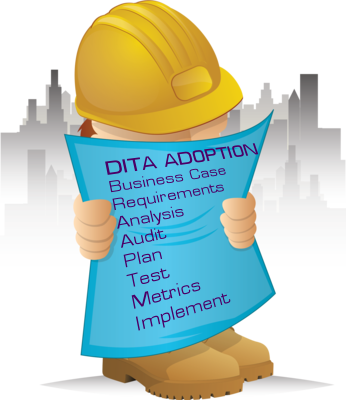 Like any other major project that changes your tools, processes, and outputs, careful project planning for DITA adoption is the key to success. Transformative projects like DITA adoption require substantial planning and resources, to ensure that the people, processes and technology are ready and able to succeed.
Like any other major project that changes your tools, processes, and outputs, careful project planning for DITA adoption is the key to success. Transformative projects like DITA adoption require substantial planning and resources, to ensure that the people, processes and technology are ready and able to succeed.
Introduction
Although a DITA adoption project can seem overwhelming, one of the techniques for managing its many parts is to split it up into its phases: investigation, selling, pilot, adoption, and continuous improvement. If you are more familiar with project phases as outlined in PMBOK or other methodologies, these DITA adoption phases align very nicely with initiation, planning, development, testing, and implementation. Just remember the idea is to break the process into manageable chunks. Splitting adoption into phases allows you to easily identify specific goals and progress through adoption in a careful way, without plunging in head first.
Communication, Planning and Risk Management: Key Factors to Success
DITA adoptions can stall, be sidelined for other priorities, or simply be deemed (usually incorrectly) too risky to proceed. No matter how these difficulties manifest, they are based on one core cause: insufficient enterprise support due to insufficient enterprise understanding. The solution sounds simple, but requires stamina, forethought, and skill:
- Sponsor support
- Risk management
- Careful project planning including targeted, frequent communications to the enterprise
Senior management looks for evidence that the project can and will succeed: past experience and strong data about the risks of moving forward, and NOT moving forward are essential. Detailed, thoughtful planning allows you to approach the project in a measured, step-by-step way without forcing the enterprise to commit irrevocably, without sufficient evidence of likely success. As you move forward with a well-planned project, demonstrable results combined with on-going communication fuel subsequent activity.
Sponsor Support
A sponsor is a mid- or high-level executive in the company who is visibly committed to supporting your efforts to adopt DITA. The sponsor understands what you are attempting at a high level and can provide invaluable help and feedback when trying to present your business case and ROI to senior members of the enterprise. The sponsor’s involvement is critical, particularly in the first stages of communication with the enterprise. They get the right people to the table and can get them to listen to what would ordinarily seem like just another request for more budget.
Risk Management
As with any project, appropriate management of risks can save you time and money later on, often letting you avoid the need to circle back and perform activities twice (or more), or even worse, suffer the consequences of a failed or cancelled project. Your project plan should include identification of the risks associated with your project as well as how you anticipate mitigating them. The following are frequent and high-impact risks that you’ll want to take into account from the beginning.
| Risk | Mitigation |
| Enterprise doesn’t grasp value |
|
| Enterprise won’t support or authorize budget |
|
| Resources lack knowledge of processes and tools |
|
| Author resistance to new tools processes, or fear of downsizing |
|
| IT is bottleneck |
|
DITA Adoption Planning Template
Use the template we’ve created to get started with your DITA Adoption Planning. Since project planning tools vary from organization to organization, we’ve created the template as an Excel file that details the high-level activities of DITA adoption from beginning to end. For most of these high-level activities, you should create sub-tasks that further detail what needs to be done and by whom. While content creators rarely get into the field to polish their project management skills, successfully adopting DITA as an enterprise initiative requires them. Planning, monitoring, evaluation, and constant communication are core to managing the effort, and those are the kind of skills content pros can bring to the table.